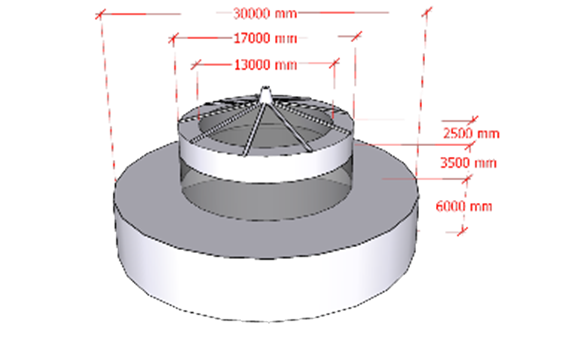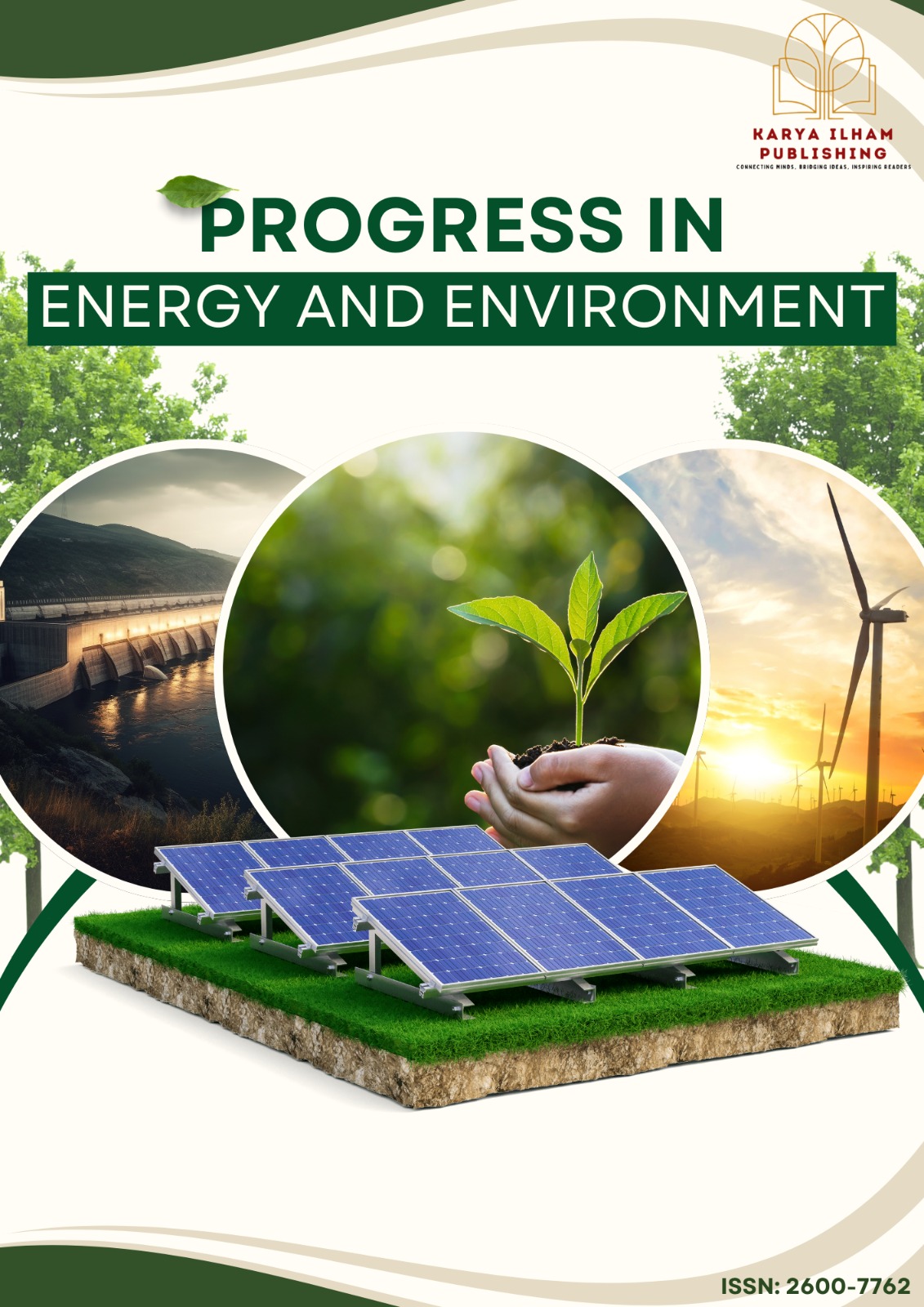Daylight Performance of Louvred Shading on Atrium Skylight in Exhibition Gallery
Prestasi Pencahayaan Siang bagi Teduhan Berjalur pada Atrium Bumbung Kaca di dalam Galeri Pameran
DOI:
https://doi.org/10.37934/progee.31.2.5166Keywords:
Daylighting, Atrium Skylight, Tropical Climate, Shading Device, Exhibition Gallery, Pencahayaan Siang, Bumbung Kaca Atrium, Iklim Tropika, Alat Teduhan, Galeri PameranAbstract
Daylighting is often underutilized in regions characterized by tropical climates. In Malaysia, architectural designs frequently incorporate enclosed walls and facades to minimize solar heat gain. However, this approach limits the penetration of natural daylight into deeper interior spaces. As a result, larger and deeper spaces, such as exhibition galleries, often rely on artificial lighting to achieve adequate illumination, thereby increasing the building’s overall energy demand. To mitigate the reliance on artificial lighting, this study aims to identify and evaluate the effectiveness of vertical and horizontal louvred shading systems applied to an exhibition gallery's atrium skylight within a tropical climate context. Both vertical and horizontal louvred shading configurations were analysed using the VELUX Daylight Visualizer simulation software. The Phase 1 simulation results indicate that the vertical louvred Type D (D = 600 mm, L = 300 mm) and horizontal louvred Type 3 (D = 150 mm, L = 450 mm) configurations demonstrated superior daylight performance when applied independently to the atrium skylight. In contrast, the Phase 2 simulation revealed that combining both louvred shading systems significantly enhances daylight performance. The integrated Type D2 configuration—comprising vertical louvred Type D (D = 600 mm, L = 300 mm) and horizontal louvred Type 2 (D = 150 mm, L = 300 mm)—achieved the most optimal daylight distribution for the atrium skylight in the exhibition gallery compared to other design configurations.
Pencahayaan semula jadi sering kurang dimanfaatkan di kawasan yang beriklim tropika. Di Malaysia, reka bentuk seni bina sering menggabungkan dinding dan mukaan tertutup untuk meminimumkan kenaikan haba solar. Walau bagaimanapun, pendekatan ini mengehadkan penembusan cahaya semula jadi ke ruang dalaman yang lebih dalam. Akibatnya, ruang yang lebih besar dan dalam seperti galeri pameran sering bergantung pada pencahayaan tiruan untuk mencapai tahap pencahayaan yang mencukupi, sekali gus meningkatkan permintaan tenaga keseluruhan bangunan. Bagi mengurangkan kebergantungan terhadap pencahayaan tiruan, kajian ini bertujuan untuk mengenal pasti dan menilai keberkesanan sistem teduhan berjalur menegak dan mendatar yang digunakan pada atrium bumbung kaca galeri pameran dalam konteks iklim tropika. Kedua-dua konfigurasi teduhan berjalur menegak dan mendatar telah dianalisis menggunakan perisian simulasi VELUX Daylight Visualizer. Keputusan simulasi Fasa 1 menunjukkan bahawa konfigurasi teduhan berjalur menegak Jenis D (D = 600 mm, L = 300 mm) dan teduhan berjalur mendatar Jenis 3 (D = 150 mm, L = 450 mm) memberikan prestasi pencahayaan semula jadi yang lebih baik apabila digunakan secara berasingan pada atrium bumbung kaca. Sebaliknya, simulasi Fasa 2 menunjukkan bahawa gabungan kedua-dua sistem teduhan berjalur dapat meningkatkan prestasi pencahayaan semula jadi dengan ketara. Konfigurasi gabungan Jenis D2—terdiri daripada jalur menegak Jenis D (D = 600 mm, L = 300 mm) dan jalur mendatar Jenis 2 (D = 150 mm, L = 300 mm)—mencapai taburan pencahayaan semula jadi yang paling optimum untuk atrium bumbung kaca di galeri pameran berbanding dengan konfigurasi reka bentuk yang lain.
References
[1] Z. Ke, H. Zhang, X. Jia, J. Yan, X. Lv, H. Yu, N. Gao, W. Zeng, Y. Liu, and N.H. Wong, Research on Energy Efficiency and Decarbonization Pathway of Nearly Zero Energy Buildings Based on System Dynamic Simulation. Developments in the Built Environment 17 (2024) 100310. https://doi.org/10.1016/j.dibe.2023.100310
[2] F.S. Hafez, B. Sa’di, M. Safa-Gamal, Y.H. Taufiq-Yap, M. Alrifaey, M. Seyedmahmoudian, A. Stojcevski, B. Horan, and S. Mekhilef, Energy Efficiency in Sustainable Buildings: A Systematic Review with Taxonomy, Challenges, Motivations, Methodological Aspects, Recommendations, and Pathways for Future Research. Energy Strategy Reviews 45 (2023) 101013. https://doi.org/10.1016/j.esr.2022.101013
[3] J.M. Loewen, M.D. Levine, and J.F. Busch, ASEAN-USAID Buildings Energy Conservation Project. Final report, Volume 3: Audits, Berkeley, CA (United States), 1992. https://doi.org/10.2172/10167947.
[4] S. Murtyas, R. Qian, T. Matsuo, N.W. Tuck, S.A. Zaki, and A. Hagishima, Thermal Comfort in a Two-Storey Malaysian Terrace House: Are Passive Cooling Methods Sufficient in Present and Future Climates?, Journal of Building Engineering 96 (2024) 110412. https://doi.org/10.1016/j.jobe.2024.110412
[5] J. Mardaljevic, Daylight, Indoor Illumination, and Human Behavior, in: Encyclopedia of Sustainability Science and Technology, Springer New York, New York, NY, 2012: pp. 2804–2846. https://doi.org/10.1007/978-1-4419-0851-3_456
[6] C.L. Robbins, Daylighting: design and analysis, U.S.A.: Van Nostrand Reinhold, 1986.
[7] A.A. Jamaludin, H. Hussein, N. Keumala, and A.R. Mohd Ariffin, The Dynamics of Daylighting at a Residential College Building with the Internal Courtyard Arrangement. International Journal of Architectural Research: ArchNet-IJAR 9 (2015) 148. https://doi.org/10.26687/archnet-ijar.v9i3.588.
[8] Bushra Obeidat, Mohammed Alshayeb, and Afnan Barr, Comparing the Effects of Daylight Illuminance and Solar Radiation on Students’ Spatial Behaviour in Campus’ Outdoor Spaces, in: Proceedings of the 33rd PLEA International Conference, Edinburgh, UK, 2017: pp. 3325–3331.
[9] G. Datta, Effect of Fixed Horizontal Louver Shading Devices on Thermal Perfomance of Building by TRNSYS Simulation Renewable Energy 23 (2001) 497–507. https://doi.org/10.1016/S0960-1481(00)00131-2
[10] Jeong Tai Kim, and G. Kim, Advanced External Shading Device to Maximize Visual and View Performance. Indoor and Built Environment 19 (2010) 65–72. https://doi.org/10.1177/1420326X09358001
[11] J. Lee, M. Alshayeb, and J.D. Chang, A Study of Shading Device Configuration on the Natural Ventilation Efficiency and Energy Performance of a Double Skin Façade. Procedia Engineering 118 (2015) 310–317. https://doi.org/10.1016/j.proeng.2015.08.432
[12] M. Mahdavinejad, and S. Mohammadi, Synthesis and Optimization of Louver-Driving Mechanism for Innovative Daylighting System in Deep-Plan Building. The Turkish Online Journal of Design, Art and Communication 6 (2016) 174–187. https://doi.org/10.7456/1060ASE/018
[13] F.F. Hernández, J.M. Cejudo López, J.M. Peña Suárez, M.C. González Muriano, and S.C. Rueda, Effects of Louvers Shading Devices on Visual Comfort and Energy Demand of an Office Building. A Case of Study. Energy Procedia 140 (2017) 207–216. https://doi.org/10.1016/j.egypro.2017.11.136
[14] K. Almutairi, S. Algarni, T. Alqahtani, N. Bharath Kumar, and D. Prayogo, The Optimum Model of Horizontal Canopies on Reducing Building Energy Consumption. Sustainable Energy Technologies and Assessments 53 (2022) 102519. https://doi.org/10.1016/j.seta.2022.102519
[15] F. De Luca, A. Sepúlveda, and T. Varjas, Multi-Performance Optimization of Static Shading Devices for Glare, Daylight, View and Energy Consideration. Building and Environment 217 (2022) 109110. https://doi.org/10.1016/j.buildenv.2022.109110
[16] Y. Xue, and W. Liu, A Study on the Optimization of Atrium Daylight and Energy Performance through Skylight and Shading Design in Commercial Buildings in Cold Zones. Buildings 13 (2023) 228. https://doi.org/10.3390/buildings13010228
[17] Z. Sahputra, E. Meutia, M.H.A. Edytia, A. Frannata, P. Shafwa, D. Octaviana, and F. Amelia, Daylight Strategies in Learning Space in Covid-19 Pandemic, in: 2022. https://doi.org/10.2991/assehr.k.220703.023
[18] D. Seftyarizki, A. Prihatiningrum, and A. Ramawangsa, Thermal and Visual Comfort Analysis Using CBE Tools And Velux Simulation of Classroom in R.21 in Gedung Kuliah Bersama V University of Bengkulu. IOP Conference Series: Earth and Environmental Science 738 (2021) 012007. https://doi.org/10.1088/1755-1315/738/1/012007
[19] M. Pinto, Ricardo M. S. F. Almeida, P. G. Pinho, and L. T. Lemos, Daylighting in classrooms - the daylight factor as a performance criterion, in: ICEH 2014 - 3rd International Congress on Environmental Health, 2014.
[20] H.F.O. Müeller, Daylighting, in: Sustainability, Energy and Architecture, Elsevier, 2013: pp. 227–255. https://doi.org/10.1016/B978-0-12-397269-9.00009-8
[21] Yii Sern Christopher Heng, Farhana Mohd Razif, Sharifah Fairuz Syed Fadzil, Louis Ting Kwang Liou, and Boon Jia Jun, Daylighting Performance of Integrated Venetian Blinds with Horizontal Light Pipe System for Deep Plan High-Rise Office in Tropical Climate. Journal of Advanced Research in Applied Sciences and Engineering Technology 28 (2022) 144–153. https://doi.org/10.37934/araset.28.3.1441530

Downloads
Published
Issue
Section
License
Copyright (c) 2025 Progress in Energy and Environment

This work is licensed under a Creative Commons Attribution-NonCommercial 4.0 International License.















